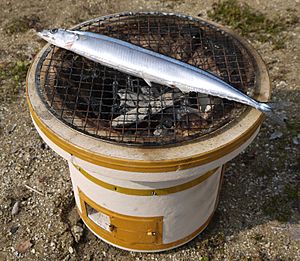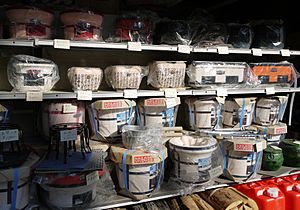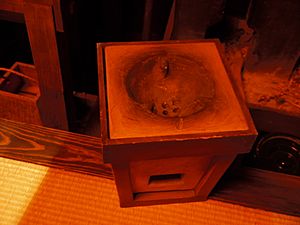Shichirin facts for kids
The shichirin is a small, portable grill from Japan. It's used for cooking with charcoal. Imagine a mini barbecue that you can easily move around!

Contents
What's in a Name?
The word shichirin comes from two Japanese words: shichi (meaning "seven") and rin (meaning "wheel" or "ring").
There's a cool story about how it got its name! Long ago, during the Edo period in Japan, there was a small coin called a rin. People say the shichirin was a very affordable way to cook because the charcoal needed for one cooking session only cost about seven rin. This made it a popular cooking tool for many families.
What is a Shichirin Like?
The shichirin is a light, small, and easy-to-carry cooking stove. Most modern shichirin are made from special blocks of diatomaceous earth. This is a natural material that is dug up from the ground. Workers carefully carve or shape these blocks, then bake them in a hot oven. After that, metal parts are added to finish the grill.
Some shichirin are made with two layers of ceramic material, one inside and one outside. This helps them hold heat well.
Charcoal is the main fuel used in a shichirin. Even today, shichirin are made in much the same way as they were during the Edo period. They come in different shapes, like round, square, or rectangular, and also in various sizes. In some parts of Japan, like the Kansai region, people might call them kanteki.
Shichirin vs. "Hibachi" in North America
If you're in North America, you might hear small barbecue grills like the shichirin called "hibachi" or "hibachi-style." However, in Japan, a hibachi is actually a small heating device that isn't usually used for cooking food.
It seems that when these grills first came to North America, they were mistakenly called "hibachi." Sometimes, the word "hibachi" is even used incorrectly in the United States to describe Japanese steak houses or teppanyaki restaurants, where food is cooked on a large iron griddle.
How to Use a Shichirin
Charcoal is the best fuel for a shichirin.
- For cooking outdoors, people usually use black charcoal.
- If you're cooking indoors, a special type of white charcoal called Binchōtan is often preferred. Binchōtan doesn't produce as much smoke or smell when it burns. It also stays hot for a longer time and is less likely to cause dangerous flare-ups.
- For a cheaper option, some people use sawdust charcoal.



